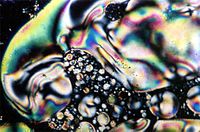
Photo from wikipedia
NMR spectroscopy in anisotropic media has emerged as a powerful technique for the structural elucidation of organic molecules. Its application requires weak alignment of analytes by means of suitable alignment… Click to show full abstract
NMR spectroscopy in anisotropic media has emerged as a powerful technique for the structural elucidation of organic molecules. Its application requires weak alignment of analytes by means of suitable alignment media. Although a number of alignment media, that are compatible with organic solvents, have been introduced in the last 20 years, acquiring a number of independent, non-linearly related sets of anisotropic NMR data from the same organic solvent system remains a formidable challenge, which is however crucial for the alignment simulations and deriving dynamic and structural information of organic molecules unambiguously. Herein, we introduce a programmable strategy to construct several distinct peptide-based alignment media by adjusting the amino acid sequence, which allows us to measure independent sets of residual dipolar couplings (RDCs) in a highly efficient and accurate manner. This study opens a new avenue for de novo structure determination of organic compounds without requiring prior structural information.
Journal Title: Chemical Science
Year Published: 2022
Link to full text (if available)
Share on Social Media: Sign Up to like & get
recommendations!